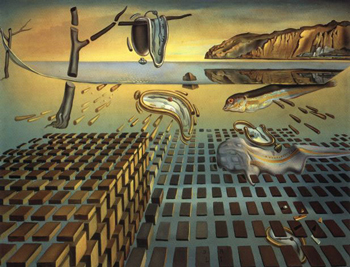| Search Art Prints | ||||||||||||||||||||
| Search Artists | ||||||||||||||||||||

|
||||||||||||||||||||
|
|
|||||||||||||||||||

Disintegration of Persistence of Memory

|
This later work of Salvador Dali's represents his movement away from his surrealist period. Dali's new scientific interests were taking hold and he wished to make a distinct and clear break between his new work and his former paintings. In order to do so, he painted the Disintegration of Persistence of Memory as a deconstruction of a specific previous work.
In the 1950s, Dali was fascinated with the connection between science and math and metaphysics and religious faith. Instead of representing the interior or psychological world through surrealistic images (as he had previously done), he now wanted to explore the external world through physics.
Disintegration of Persistence of Memory is a figurative breaking down of his earlier work, The Persistence of Memory. In the new work, the seascape of the previous painting is pulled back to reveal a new grid-like structure meant to visually represent quantum mechanics. The grid of blocks is intended to show the disintegration and reintegration of matter in relation to the space/time continuum. The melting watches which had been the focal point of Persistence of Memory are seen here as a reminder of Dali's earlier interest in using physical, mundane objects to represent the expression of subconscious human desires and drives. In his later painting, it is clear that the subconscious is no longer Dali's primary focus.
With the Disintegration of Persistence of Memory, Dali re-evaluates and reinvents his own artistic history based on his new fascination with and understanding of the world of science. This work represents an important shift in the artist's creative path.











